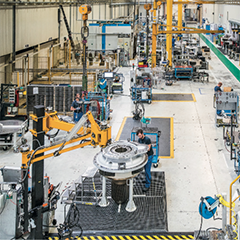ZF is a leading pioneer in cost-efficient wind turbines. The reduction of Levelized Cost of Energy (LCoE) is their principal aim. The SHIFT platform concept means it’s now possible to optimize gearboxes for specific-site loads. PES wanted to know more.
LCoE of wind energy happens with big evolutions in wind technology. Big is important. There are a couple of ways to produce more power from the wind in a given area.
The first is with larger rotors and blades to cover a wider area. That increases the capacity of the turbine, i.e., its total potential production.
The second is to situate the blades higher, where the wind blows more steadily. That increases the turbine’s ‘capacity factor,’ i.e., the amount of power it actually produces relative to its total potential. The more variable a source is, the more backup is needed to firm it up and make it reliable. By making wind less variable and more reliable, higher capacity factors reduce backup costs.
With increasing capacity factors wind can spread its energy out over a longer period, easing wholesale price pressure during low demand. By extending its hours of operation, a high-capacity-factor turbine is more likely to be producing during demand peaks, when power is most valuable.
Modular gearbox platform designs should have one ultimate goal – LCoE reduction. LCoE reduction drives customer’s product roadmaps and challenges in adapting to new markets and dynamics. A modular platform approach is helping customers to realize cost-efficient new generation wind turbines.
How modular wind gearbox platforms can reduce LCOE
A new gearbox development comes at a cost. In classic designs, these costs, i.e. CAPEX + OPEX + Validation + Design, come at the expense of the wind turbine OEMs. Platform designs take into account the requirements of multiple markets and offer a solution for multiple customers. Hence development costs are shared, significantly lowering the initial development cost compared to a dedicated design.
Current market conditions result in fast changes leading to a shorter product lifetime. With the implementation of auction systems, the number of development cycles and upgrades are increasing still further. High flexibility in gearbox designs needs to keep pace with this LCoE trend, while extending product lifetime to acceptable levels avoiding extensive development and investment costs. ZF’s SHIFT platform concept allows wind turbine OEMs to reduce the number of gearbox developments while offering flexibility in turbine performance upgrades and the confidence to adopt forward pricing in auction bidding.
It is crucial for OEMs to collaborate with suppliers who enable a fast time to market. ZF has selectively developed a number of platforms. These platforms have been pre-developed and validated, reducing time to market significantly. In addition, the SHIFT platform includes pre-designed and validated upgradability, which allows customers to follow future market trends rapidly.
Current practice teaches us that wind turbine OEMs provide a design load set for a specific turbine, covering generally around 90% of the sites in their target markets. This means that the gearbox is overrated for sites where loads are lower than the pre-defined design loads. The SHIFT platform allows OEMs customers to optimize the gearbox to these site-specific loads by selecting the proper variant, optimizing the LCoE per specific wind site. Customers can use platform flexibility to mix variants within a single wind site further optimizing project development costs.



























